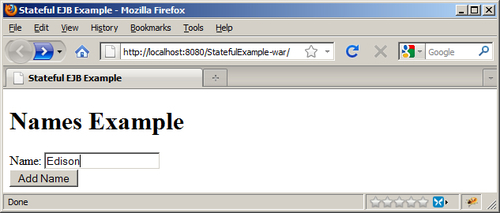In order to illustrate the creation of a stateful EJB, we will use a bean to maintain a list of names. A name will be entered in the index.jsp page and passed to a servlet. The servlet will add the name to the stateful bean. Unique to the stateful EJB is the process of passivation. When a stateful bean is experiencing a period of inactivity, the EJB container may decide to remove it from memory temporarily. This process is called passivation. Most of the state of the EJB is saved automatically except for transient fields. When the EJB is restored, the stateless EJB has its original content except for the transient fields.
Creating a stateful session bean requires:
- Annotating a class with the @Stateful annotation
- Adding appropriate business methods
Earlier versions of EJB required the use of local and/or remote interfaces. This is no longer necessary.
To use a session bean, inject the EJB into the client using the @EJB annotation followed by the declaration of the bean. In this recipe, we will use a servlet to demonstrate this process. Remember, it is important to use the @EJB annotation, otherwise the bean will not be managed by the EJB container and it will not be able to take advantage of the support provided to EJBs.
Let's start by creating a Java EE application called StatefulExample. Add a package called packt and a stateful EJB called NamesBean to the EJB module. Also, add a package called servlet and a servlet called NamesServlet to the WAR module.
The NamesBean EJB maintains a list of names. Two methods are used. The addName method adds a name to the list and the getNames method returns a list of names.
@Stateful
@LocalBean
public class NamesBean {
private List<String> names;
@PostConstruct
private void initialize() {
names = new ArrayList<String>();
}
public void addName(String name) {
names.add(name);
}
public List<String> getNames() {
return names;
}
}
The NamesServlet injects the NamesBean and uses it to add names passed to it.
public class NamesServlet extends HttpServlet {
@EJB
private NamesBean names;
private List<String> list;
protected void processRequest(HttpServletRequest request, HttpServletResponse response)
throws ServletException, IOException {
response.setContentType("text/html;charset=UTF-8");
PrintWriter out = response.getWriter();
try {
names.addName(request.getParameter("name"));
list = names.getNames();
out.println("<html>");
out.println("<head>");
out.println("<title>NamesServlet</title>");
out.println("</head>");
out.println("<body>");
out.println("<h3>Current List of Names</h3>");
for(String name: list) {
out.println(name + "<br>");
}
out.println("</body>");
out.println("</html>");
} finally {
System.out.println("Error");
out.close();
}
}
}
A simple implementation of the index.jsp pages prompts the user for a name and passes the name to the NamesServlet.
<%@page contentType="text/html" pageEncoding="UTF-8"%> <!DOCTYPE HTML PUBLIC "-//W3C//DTD HTML 4.01 Transitional//EN" "http://www.w3.org/TR/html4/loose.dtd"> <html> <head> <meta http-equiv="Content-Type" content="text/html; charset=UTF-8"> <title>Stateful EJB Example</title> </head> <body> <h1>Names Example</h1> <form action="NamesServlet" method="get"> Name: <input type="text" name="name" /><br /> <input type="submit" value="Add Name" /> </form> </body> </html>
Start the application using the URL provided in the following screenshot. Enter a name and press the Add Name button:

When the index.jsp page is executed repeatedly, names are added to the list and the NamesServlet page displays a list similar to the one shown in the following screenshot:

The NamesBean class used an ArrayList to maintain a list of names. A method was provided to add a name and to return a List of the names. The addName method used the add method of the List to add a name. The getNames method returned this ArrayList. Notice that names is a reference to an object that implements the List interface. However, an ArrayList object was actually assigned. By using the more generic List interface, in the future if we change our implementation, calling methods are not affected.
In the NamesServlet, the getParameter method returned a value associated with the parameter name. Notice this name was declared in the input tag of the index.jsp file. The value entered by the user was passed to the servlet using this parameter.
When the stateful EJB is passivated, it is sometimes necessary for the EJB to perform additional actions. For example, certain resources, such as database connections may need to be closed. Likewise, when the EJB is restored the resources may need to be restored. The @PrePassivate and @PostActivate methods are used to designate which methods need to be executed when passivation or restoration occurs.
@PrePassivate
private void prepareForPassivation() {
// Perform prepassivation tasks
}
@PostActivate
private void restoreFromPassivation() {
// Restore stateful EJB
}
